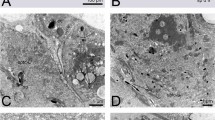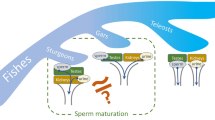Abstract
WHILE the histology of spermatogenesis s.str., that is, the maturation of the spermatids to form ripe spermatozoa in Lumbricus terrestris L., is known in detail, explanations of the orientation of the developing spermatid remain somewhat obscure. The only complete and easily available information is contained in the general text-book of Borradaile1, where diagrams show the ‘tail’ of the sperm arising at the cytoplasmic vesicle at the periphery of the mirula and remaining in this position during its subsequent elongation away from the cytophore. The cytoplaemic vesicle and the cytophore are shown in Fig. 1 (c.v., cph.). The account of Hesse2 interprets the orientation of the spermatid in the same way as Borradaile, stating that the acrosome or ‘head’ end arises from the cytoplasmic pedicle which is directed towards the centre of the morula (Fig. 1, c.p.). Depdolla3, however, explains the orientation in the reverse way and regards the cytoplasmic vesicle as representing the acrosome or ‘head’ end of the sperm, and states that the ‘tail’ develops from the cytoplasmic pedicle. More recent work by Chatton and Tuzet4, who made a very detailed histological examination, confirms this view, though no figures are given in their work of the final relationship of the ripe spermatozoa to the cytophore.
This is a preview of subscription content, access via your institution
Access options
Subscribe to this journal
Receive 51 print issues and online access
$199.00 per year
only $3.90 per issue
Buy this article
- Purchase on Springer Link
- Instant access to full article PDF
Prices may be subject to local taxes which are calculated during checkout
Similar content being viewed by others
References
Borradaile, L. A., “A Manual of Elementary Zoology”, sixth edit., 245 (1930).
Hesse, E., Arch. Zool. Exp. Gen., 3, 10, 27 (1909).
Depdolla, P., Zool. Anz., 28; Bibliographia Zoologica, 10, 545 (1905); Z. wiss. Zool., 81, 632 (1906).
Chatton, E., and Tuzet, O., C.R. Acad. Sci., Paris, 214, 373 (1941); 214, 894 (1942).
Whitehouse, R. H., and Grove, A. J., “The Dissection of the Earthworm”, 49 (Univ. Tutorial Press, 1949).
Wilmott, S., J. Helminthology, 24, Nos. 1 and 2, 1 (1950).
Author information
Authors and Affiliations
Rights and permissions
About this article
Cite this article
RAWSON, D. Spermatogenesis in Lumbricus terrestris L., Müll.. Nature 171, 264–265 (1953). https://doi.org/10.1038/171264a0
Issue Date:
DOI: https://doi.org/10.1038/171264a0
Comments
By submitting a comment you agree to abide by our Terms and Community Guidelines. If you find something abusive or that does not comply with our terms or guidelines please flag it as inappropriate.



